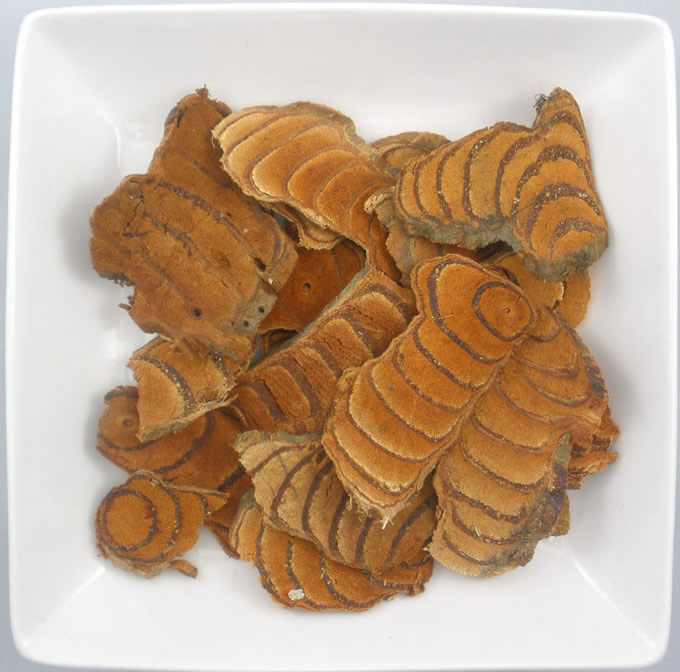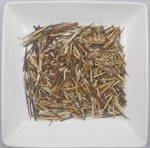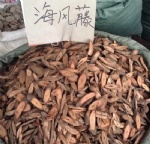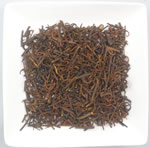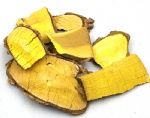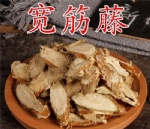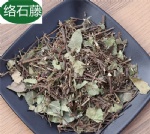
|
KWOK SHING HONG |
|
|||
Products CategoryContact Us
Add: China |
CAULIS SPATHOLOBIProduct name : CAULIS SPATHOLOBI Item : 79351484302 Details :Millipeda is also known as blood wind, blood vine, big blood vine, blood wind vine, three-leaved Milletweed, nine-layer wind. Spatholobus Spatholobus is the dried cane of leguminous vines, such as Baihua Yau Ma Teng, Mihua Bean, and Fragrant Thuja Spathiphyllum Spatholobus. wild. Spatholobus Spatholobus is named in "Chinese Medicine Chronicles" as Baihua Yaumateng, "Handbook of Identification of Traditional Chinese Medicine" is named Mihuadou, and Nanjing "Materia Medica" is named as Kunming Spatholobus Spatholobus, but the cross-sections of Spatholobus Spatholobus drawn in these three books The maps are basically similar, and whether there are any differences between the three canes remains to be investigated and studied in the future. The stems and vines of Spatholobus Spatholobus are harvested in autumn, the branches and leaves are removed, sawn into sections, and dried in the sun. Or freshly sliced and dried. Spatholobus Spatholobus is the essential vine of Dendrobium japonicus, tens of meters long. When the old stem is cut off, several eccentric rings can be seen, and chicken blood-like juice oozes from the rings. Three compound leaves alternate; terminal leaflet broadly elliptic, 12-20cm long, 7-15cm wide, sharp at first, round or nearly heart-shaped at the base, sparsely short bristles above, short yellow beard between veins on the back , the base of the lateral leaflets is skewed, the petiole is about 6mm long; the stipules are needle-shaped. Panicle axillary, large, with many and dense flowers, inflorescence rachis and pedicels covered with yellow pilose; flower length about 10mm; calyx fleshy tube, 5 teeth, upper 2 teeth connate, two surfaces yellow pilose; corolla white, fleshy, flag Petals are nearly round, with claws, wing petals and keel petals are about 7mm long, with claws and ears; stamens 10, 2 groups, anthers 5 large and 5 small; ovary with white bristles. Pod tongue-shaped, 8-10cm long, with yellow pilose; 1 seed, raw pod apex. The flowering period is June-July, and the fruiting period is August-December. Mainly produced in Guangxi, Yunnan, Guangdong and other places. It is better if the rattan slices are uniform, with exudate on the cut surface, and several layers of rings formed, and the quality is firm. The main component of Caulis Spatholobus contains Gallistenol and iron. Indications for irregular menstruation due to blood deficiency, muscle numbness, weakness of muscles and bones, soreness of waist and knees, paralysis and other diseases. Pharmacological effects: 1. The effect on the hematopoietic system: According to the reports of He Shuma and others, Mihua Dougeng decoction (100%) has a blood-enriching effect on experimental rabbit anemia, which can increase blood cells and increase hemoglobin. It has a stronger effect than the thuja vine. In 1989, Zhang Shufang et al. reported that Caulis Spatholobus decoction (2g/kg) had no significant effect on the recovery of peripheral cells, hemoglobin and reticulocytes in rabbits with hemorrhagic anemia: 7 litters were vaccinated in the experiment, 5 of which were 4 litters each. The remaining 2 litters each had 2 birds, a total of 24 birds. There are 13 females and 11 males, weighing 1.42-2.58kg. The 4 rabbits in the same litter were randomly divided into Salvia miltiorrhiza, Angelica sinensis, Caulis Spatholobus and control group, 5 rabbits in each group. Another 4 only observed its normal value. During the experiment, blood was taken from the ear vein at 8:30 every morning (after the first feeding) to measure hemoglobin, red blood cell count, and reticulocyte count. value. From the 4th day onwards, the blood was let out from the V-shaped opening cut at the tip of the rabbit's ear at 8:30 every morning. Once a day, for 3 consecutive days, each bloodletting is equivalent to 1% of the body weight of the day, and the total amount of bleeding is equivalent to 50% of the total blood volume. After bloodletting, 5% glucose solution was administered into the stomach to replace the lost body fluid, and the dosage was 1% of the body weight. From 1 day after the bloodletting, each group was given 20% Danshen, Angelica, and Spatholobus decoction by intragastric administration at a dose of 2 g per 1 kg of body weight, and the other group was given 10 ml of normal saline per 1 kg of body weight as a control, every day Once, for 10 consecutive days, from 1 to 13 days and 16, 18, and 21 days after the bloodletting, blood was taken from the ear vein at 8:30 every morning to check the blood picture. With the number of red blood cells and hemoglobin value before bloodletting as 100%, the average number of days for the rabbits in each group to recover to 95% after bloodletting is shown in Table 1 and Table 2 respectively; Table 3 shows the peak time of erythrocyte appearance and its level after 21 days. The above results showed that Caulis Spatholobus had no significant effect on the recovery of red blood cells, hemoglobin and reticulocytes in the ear veins of rabbits with hemorrhagic anemia. 2. Effects on blood coagulation and fibrinolysis: Effects on canine blood coagulation and fibrinolysis in vitro. Experimental dogs were exposed to the femoral artery after anesthesia, and blood was collected (put the test tube on ice immediately after blood collection), anticoagulants (sodium oxalate, Sodium citrate) 1 part plus 9 parts of whole blood, centrifuge to separate the plasma, divide the plasma into 3 parts, and add 0.03ml of normal saline, Danshen injection, and Caulis Spatholobus injection respectively. Determination of recalcification time (reflecting the internal coagulation process), prothrombin time, thrombin clotting time, plasma fibrinogen quantification and vovoglobulin lysis test. It can be seen that Spatholobus Spatholobus (each 1ml contains 3mg of crude drug) has no obvious effect on the process of coagulation and fibrinolysis of isolated canine blood. 3. Inhibiting the heart and lowering blood pressure: 50% Jixueteng decoction has a slight inhibitory effect on the in vitro and in vivo hearts of toads. Giving 0.43-0.5g crude drug/kg decoction to anesthesiologists and 0.3g crude drug/kg decoction to dogs can cause blood pressure to drop; but it has a contraction effect on isolated ears and toad blood vessels. 4. Anti-cancer effect: The dose in vitro test is 500 nanograms (hot water extract)/ml, and the inhibition rate to JTC-26 is 94.4%. Anti-tumor drugs are screened by phage method, and this product has anti-phage effect. 5. Regulation of lipid metabolism: Japanese quails were fed with Caulis Spatholobus decoction 6g/kg for 14 days and 47 days, which can increase HDL2-C, reduce HDL3-C, and increase the ratio of HDL2-C/HDL3-C This ratio is an important index to evaluate lipid metabolism and arteriosclerosis (the ratio of HDL2-C/HDL3-C in patients with coronary heart disease is lower than that in patients without coronary heart disease). For aortic and brachiocephalic artery lesions, Caulis Spatholobus has inhibitory effect. The clinical application of Spatholobus Spatholobus: It is used for nourishing blood and nourishing blood, promoting blood circulation and expelling wind, dredging collaterals and relieving pain. 1. Treat rheumatic arthralgia. It is most suitable for the elderly and women who are usually weak in Qi and blood and suffer from chronic rheumatism. It is best to mix with blood-tonifying and rheumatism-dispelling medicines, such as mulberry, black bean clothing, etc., or with Achyranthes bidentata, half maple lotus, and sweetgum to prevent self. Sea wind rattan, etc., such as spaghetti soup. 2. For the treatment of weakness of the hands and feet, numbness, paralysis, dizziness of the elderly, caused by blood stasis, stroke-like, etc. (including limb paralysis caused by cerebrovascular accidents), you can use Millipede spatholobus to regulate qi and blood during the stable condition , stagnant and active, with mulberry, salvia, eucommia, cornus and so on. 3. It is more suitable for treating irregular menstruation, amenorrhea and abdominal pain caused by blood deficiency. It is often taken together with Siwu Decoction. 4. In recent years, it has been used to treat leukopenia caused by radiation therapy in tumor patients, and the effect is relatively rapid and long-lasting. After 3 to 4 days, the leukocytes began to rise. You can use 30g of Spatholobus, with 15g of Astragalus, 5 jujubes, decoct in water, or take Spatholobus tablets and syrup. 5. Trial use in the treatment of aplastic anemia, with 60~120g of Millet Spatholobus, 2~4 eggs, eight bowls of water decocted into half a bowl of water, one dose per mouthful, long-term use. It can also be combined with other blood-enriching medicines and Polygonum multiflorum, Rehmannia glutinosa, Angelica, etc., such as Zaizhang Fang. Attached: 1. Spatholobus Spatholobus is mild in nature, and there is generally no side effect after taking it continuously for 2~3 months, and it can also be taken by those with deficiency fire; 2. Spatholobus gum (paste) has basically the same medicinal properties and functions as Spatholobus, but it has better tonifying power, better effect of nourishing blood and strengthening muscles and bones. Dosage: Take Spatholobus 15~60g daily, divided into 2~3 times. Can also be soaked in wine. Take 9~15g of Caulis Spatholobus Gum, it is best to dissolve it when taking other decoctions and take it warm. It can also be taken sooner or later after dissolving it in warm water. Those who have the habit of drinking alcohol can take it dissolved in alcohol. Prescription example: 1. Spatholobus soup: 15g of Spatholobus, 30g of Banfenghe, 15g of Angelica, 9g of Achyranthes bidentata, 15g of Liquidambar, 15g of Caulis Spatholobus, 15g of Douchi Jiang, decocted in water. 2. Aplastic anemia recipe: Caulis Spatholobus 30g, Radix Shouwu 2.4g, Danpi 9g, Rehmannia glutinosa 15g, Wuzhulong 30g, Diren 30g, Yunling 15g, Atractylodes macrocephala 15g, Angelica 12g, decoct in water (add donkey-hide gelatin if necessary) 9g). Note: In addition to the above-mentioned Mildew Spatholobus, there is a leguminous plant in Jiangxi Province, Fengcheng Mildew Spatholobus, also known as Mildew Spatholobus, which is cylindrical in shape and has only a circular ring formed by exudate. Guangxi also uses legume bright-leaved Spatholobus as Spatholobus. In Luquan County, Yunnan Province, the leguminous plant Croton vine is used as Spatholobus Spatholobus. Fengqing County, Yunnan Province (known as Shunning in ancient times) used the cane of Magnoliaceae heterogeneous Schisandra chinensis and the middle southern Schisandra chinensis as the Caulis Spatholobus, which was recorded as the original work of the Qing Dynasty according to the "Chinese Pharmacy Daciqu". Before 1961, most areas in North China, Northeast China, Central South, and East China used the plant Spathiphyllum sagittogenes (Red Teng) as Millipede spathifolia. After the publication of the third volume of "Chinese Medicine Chronicle" in 1961, some areas have been gradually changed according to the third volume, but there are still some areas that are still used as Mildew. In Yunnan, Jiangxi, Guangxi and other producing areas of Caulis Spatholobus, the local products are mostly processed into Caulis Spatholobus paste and sold all over the country. Some of them add some auxiliary materials when boiling the ointment, such as the syrup made from glutinous rice and malt in Fengqing County, Yunnan Province. The medicinal liquid boiled with safflower, Dipsacus, Achyranthes bidentata, and black beans, and then mixed with Caulis Spathifolia Ointment, concentrated into a paste. Spatholobus Spatholobus is rectangular, dark brown on the surface, smooth and shiny, slightly fragrant, sweet and astringent. "History of Traditional Chinese Medicine" records that Fengqing Spatholobus Spatholobus is said to be processed from Fengcheng Spatholobus Spatholobus, but according to "Handbook of Traditional Chinese Medicine Identification", it is recorded that Spatholobus Spatholobus used in Yunnan Fengqing is the product of Magnoliaceae heteromorphic southern Schisandra and middle Schisandra cane. Barcode: 79351484302 Ingredients: Caulis Spatholobus Specifications: 16oz (454g) Efficacy: nourishing blood, promoting blood circulation, dredging collaterals. For irregular menstruation, blood deficiency and chlorosis, numbness and paralysis, rheumatic arthralgia. Send Inquiry : |
Home
|
About Us
|
Products
|
News
|
Feedback
|
Contact Us
|
SiteMap
Copyright © 2025 KWOK SHING HONG All Rights Reserved
Copyright © 2025 KWOK SHING HONG All Rights Reserved






 KWOK SHING HONG
KWOK SHING HONG  藤茎类
藤茎类 